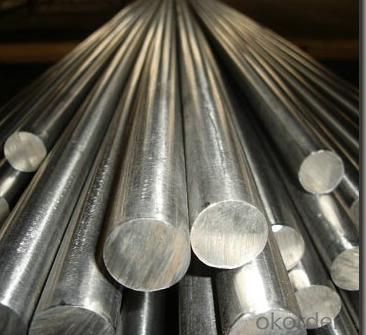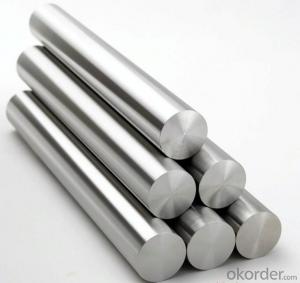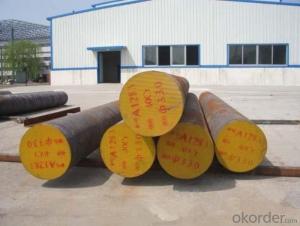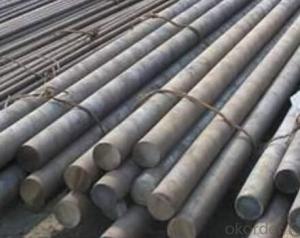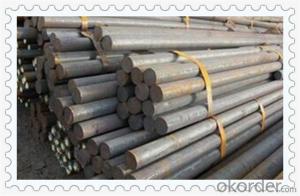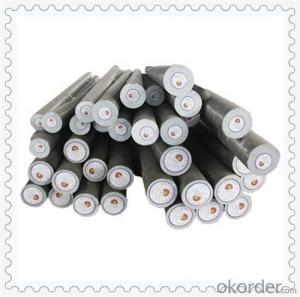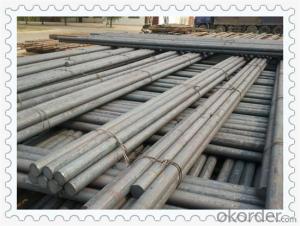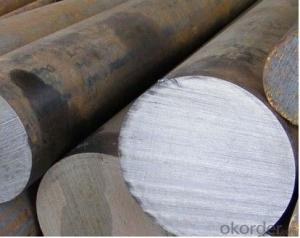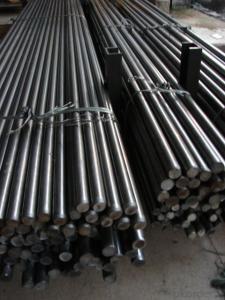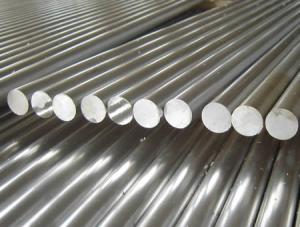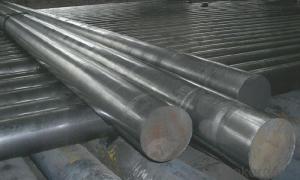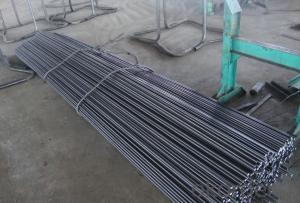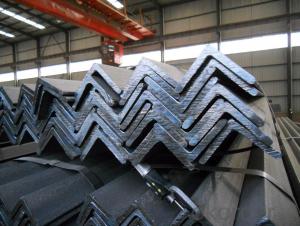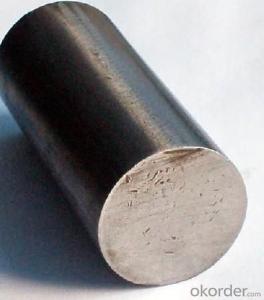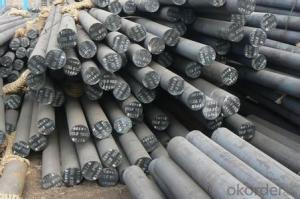Cold Drawn Steel Round Bar with High Quality-75mm-100mm
- Loading Port:
- China Main Port
- Payment Terms:
- TT or LC
- Min Order Qty:
- 100 m.t
- Supply Capability:
- 10000 m.t/month
OKorder Service Pledge
OKorder Financial Service
You Might Also Like
Cold Drawn Steel Round Bar with High Quality-75mm-100mm
Specifications:
1.Size: 75mm-100mm
2.Material: AISI 1045/DIN 1.1191/JIS S45C/GB 45
3.Chemical analysis:
C | Si | Mn | P≤ | S≤ | Cr |
0.40~0.60 | 0.20~0.30 | 0.70~0.90 | 0.030 | 0.030 | 0.01~0.03 |
4.Process: EAF + LF + VD + Forged + Heat Treatment (optional)
5.Delivery condition:Hot forged +Rough machined (black surface after Q/T)+ Turned (optional)
6.Technical Data: Chemical Composition, Physical Properties and Mechanical Testing.
7. Test: Ultrasonic test according to SEP 1921-84 3C/c.
8. Standard: GB, AISI, ASTM, DIN, JIS, BS, etc.
9. Quality Management Certification: ISO 9001:2008.
10. Main application:
(1)It is widely used in machinery manufacturing.
(2) For the manufacture of high strength requirements parts, such as gears, shafts, piston pin and the uneven force big machining parts, forgings, stampings and bolts, nuts, pipe joint.
FAQ of Cold Drawn Steel Round Bar with High Quality-75mm-100mm:
Q1: Why buy Materials & Equipment from OKorder.com?
A1: All products offered byOKorder.com are carefully selected from China's most reliable manufacturing enterprises. Through its ISO certifications, OKorder.com adheres to the highest standards and a commitment to supply chain safety and customer satisfaction.
Q2: How do we guarantee the quality of our products?
A2: We have established an advanced quality management system which conducts strict quality tests at every step, from raw materials to the final product. At the same time, we provide extensive follow-up service assurances as required.
Q3: How soon can we receive the product after purchase?
A3: Within three days of placing an order, we will arrange production. The shipping date is dependent upon the quatity, how many sizes you want and the plan of production, but is typically 1 month to 2 month days from the beginning of production.
Images of Cold Drawn Steel Round Bar with High Quality-75mm-100mm:
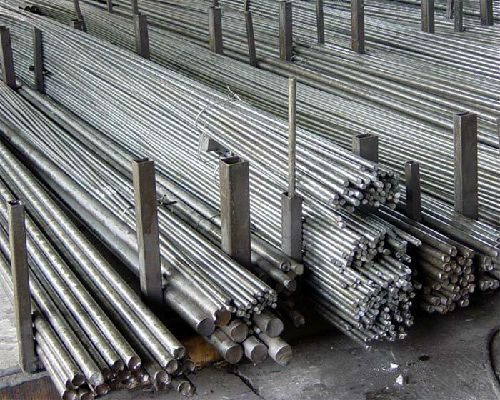
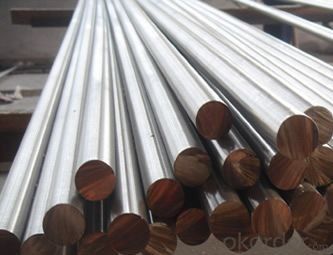
- Q: How do you determine the strength of a steel round bar?
- Various methods can be used to determine the strength of a steel round bar, including physical testing and material specifications. One commonly used method involves conducting a tensile test, where the bar is pulled until it breaks. This test helps determine the ultimate tensile strength (UTS) of the steel, which is the maximum stress it can handle before fracturing. The UTS is typically measured in units of force per cross-sectional area, such as pounds per square inch (psi) or megapascals (MPa). Another important strength property to consider is the yield strength. This is the stress level at which the steel starts to permanently deform, without any increase in load. The yield strength is crucial in assessing the structural integrity of the bar, as it indicates the maximum load it can bear without undergoing plastic deformation. In addition to physical testing, the strength of a steel round bar can also be determined by examining its material specifications. Steel manufacturers provide information about the composition and mechanical properties of their products. This includes details about the steel grade, which indicates the alloying elements present in the steel and their concentrations. Different steel grades have varying strength properties, which can help assess the strength of the round bar. It is important to consider that factors like heat treatment or surface conditions can also influence the strength of a steel round bar. Heat treatment processes, such as quenching and tempering, can enhance the strength and hardness of the steel. Additionally, surface conditions like coatings or treatments can improve corrosion resistance. To accurately determine the strength of a steel round bar, it is recommended to consult the material specifications provided by the manufacturer and, if necessary, conduct physical tests like tensile testing.
- Q: What are the advantages of using silicon-alloy steel round bars?
- Silicon-alloy steel round bars offer several benefits that make them a favorable choice. Firstly, their strength and durability are exceptional, making them suitable for heavy-duty applications. Their high tensile strength allows them to withstand heavy loads and resist deformation, ensuring reliability for mechanical and structural purposes. Secondly, these round bars exhibit excellent heat resistance. The presence of silicon in the alloy enhances their ability to handle high temperatures without compromising their structural integrity. This makes them ideal for applications that involve exposure to extreme heat, such as furnace components, exhaust systems, or high-temperature equipment. Furthermore, silicon-alloy steel round bars provide remarkable corrosion resistance. The inclusion of alloying elements like chromium and nickel creates a protective oxide layer on the surface, preventing corrosion and extending their lifespan. This makes them suitable for use in corrosive atmospheres and marine environments. Additionally, these round bars offer good machinability and weldability. Their ease of forming into various shapes and sizes makes them versatile for different manufacturing processes. Moreover, their weldability allows for easy fabrication and customization, making them convenient for numerous industries. Lastly, silicon-alloy steel round bars are cost-effective. In comparison to other high-performance alloys, they are relatively more affordable, making them a cost-effective option for applications that require strength, durability, heat resistance, and corrosion resistance. In conclusion, the advantages of silicon-alloy steel round bars encompass their excellent strength and durability, good heat resistance, corrosion resistance, machinability, weldability, and cost-effectiveness. These attributes establish silicon-alloy steel as a versatile and reliable material for various industrial applications.
- Q: Grade 1 steel is round steel, grade two steel is ribbed thread steel. Are the weight of the two units the same?
- Grade two steel is ribbed steel, but the average diameter is calculated. The chemical composition of grade steel and grade two steel is different, but the density of them is the same. Therefore, the unit weight of grade 1 steel and grade two steel is the same.
- Q: How do you store excess steel round bars?
- Excess steel round bars can be stored by utilizing proper stacking techniques and ensuring a clean and dry storage area. It is recommended to stack the bars horizontally, with sturdy supports at regular intervals to prevent bending or deformation. Additionally, storing them in a covered area or using protective covers can help prevent corrosion and maintain the quality of the bars.
- Q: Why is round steel more expensive than thread steel?
- Threaded steel should be used in the construction field, there are generally two, three grade steel, grade HRB335, HRB400 also has four grades, HRB500 thread steel. Steel is divided by tolerance standard of gb. You say there is no comparable price between round bar and screw thread
- Q: How are steel round bars used in the automotive industry?
- Steel round bars are commonly used in the automotive industry for a variety of applications due to their strength, durability, and versatility. One of the main uses of steel round bars in the automotive industry is for the production of crankshafts. Crankshafts play a crucial role in converting the reciprocating motion of the pistons into rotational motion, powering the vehicle. Steel round bars are ideal for this application as they offer high tensile strength, excellent fatigue resistance, and the ability to withstand high torque loads. Steel round bars are also used in the manufacturing of axles. Axles are responsible for transferring power from the engine to the wheels, supporting the weight of the vehicle, and providing stability. Steel round bars provide the necessary strength and rigidity required to handle the heavy loads and forces experienced by the axles. Additionally, steel round bars are utilized in the production of suspension components such as tie rods and sway bars. Tie rods are crucial for steering and maintaining proper alignment, while sway bars help to control body roll and improve handling. Steel round bars are preferred for these applications because they offer excellent torsional strength, allowing them to withstand the forces and stresses encountered during steering and suspension movements. Furthermore, steel round bars find use in the production of transmission shafts. Transmission shafts are responsible for transmitting power from the engine to the wheels via the gearbox. Steel round bars are well-suited for this application due to their high strength, resistance to bending, and ability to handle the rotational forces and torque generated by the engine. In summary, steel round bars are widely used in the automotive industry for various applications such as crankshafts, axles, suspension components, and transmission shafts. Their superior strength, durability, and versatility make them an ideal choice for these critical components, ensuring the safety, performance, and reliability of vehicles.
- Q: Are steel round bars suitable for use in the mining industry?
- The mining industry finds steel round bars to be suitable for use. These bars are renowned for their strength and durability, making them an ideal choice for heavy-duty equipment and machinery in mining. They can be utilized in various ways, such as shafts, support beams, and structural components in underground mines, open-pit mines, and processing plants. The steel round bars have the capability to withstand high loads and pressures, enabling them to thrive in harsh mining environments. They possess excellent tensile strength and can endure extreme temperatures, resulting in resistance to wear, abrasion, and impact. This is especially valuable in mining operations where equipment is subjected to heavy loads, vibrations, and constant movement. Furthermore, the steel round bars are easily weldable, fabricated, and machined to meet specific requirements, making them versatile and adaptable for a wide range of mining applications. They can be customized in terms of size, length, and shape, ensuring a perfect fit for various mining equipment and structures. Beyond their strength and versatility, steel round bars also offer cost-effectiveness and long-term value. They have a long lifespan, require minimal maintenance, and can withstand the harsh conditions typically encountered in mining operations, reducing the need for frequent replacements or repairs. Overall, steel round bars are a reliable and suitable choice for the mining industry due to their strength, durability, versatility, and cost-effectiveness. They provide the necessary support and structural integrity required for mining operations, ensuring the safety and efficiency of the industry.
- Q: Are steel round bars suitable for bridge construction applications?
- Yes, steel round bars are commonly used in bridge construction applications. Steel round bars offer several advantages for bridge construction, including high strength, durability, and versatility. They can withstand heavy loads and provide the necessary structural support required for bridges. Additionally, steel round bars can be easily fabricated and welded, allowing for efficient construction processes. The use of steel round bars in bridge construction also ensures that the bridges are resistant to corrosion, which is particularly important in environments exposed to moisture or harsh weather conditions. Overall, steel round bars are a suitable and commonly used material in bridge construction applications due to their strength, durability, versatility, and resistance to corrosion.
- Q: How do you determine the strength and hardness of a steel round bar?
- The strength and hardness of a steel round bar can be determined through various testing methods, such as tensile testing and hardness testing. Tensile testing involves subjecting the steel bar to a controlled pulling force until it fractures, allowing measurement of its ultimate tensile strength and yield strength. Hardness testing, on the other hand, measures the material's resistance to indentation or scratching using methods like Rockwell or Brinell hardness tests. These tests provide quantitative values that help determine the strength and hardness of the steel round bar.
- Q: What are the different types of steel round bar surface treatments for improved wear resistance?
- To enhance wear resistance, one can apply various surface treatments to different types of steel round bars. These treatments aim to improve the steel's hardness, toughness, and overall durability, making it more resistant to wear and corrosion. The most common surface treatments for steel round bars include: 1. Nitriding: By subjecting the steel to a nitrogen-rich environment at high temperatures, a hard nitride layer forms on the surface, enhancing wear resistance and hardness. 2. Carburizing: This process involves introducing carbon into the steel's surface, creating a high-carbon layer that increases hardness and wear resistance, making it suitable for applications requiring strength and durability. 3. Induction hardening: By selectively heating the steel's surface using an induction coil and rapidly quenching it, the resulting hardened layer provides excellent wear resistance while maintaining core toughness. 4. Shot peening: This treatment entails bombarding the steel surface with small metal or ceramic particles at high velocity, inducing compressive stresses that improve fatigue life and wear resistance. 5. Thermal spraying: Using a flame or plasma torch, a coating material is melted and sprayed onto the steel surface, creating a protective layer with enhanced wear resistance and corrosion protection. 6. PVD/CVD coatings: These involve depositing a thin layer of material onto the steel surface through Physical Vapor Deposition (PVD) or Chemical Vapor Deposition (CVD). These coatings offer excellent wear resistance, low friction, and improved corrosion protection. 7. Hard chrome plating: By electroplating a layer of chromium onto the steel surface, this process provides high hardness, wear resistance, and corrosion protection. It's crucial to consider specific application requirements and the desired type of wear resistance when choosing a surface treatment. Each treatment has its own advantages and limitations, and factors such as cost, environmental impact, and performance characteristics should be taken into account when selecting the most suitable treatment for a given steel round bar.
Send your message to us
Cold Drawn Steel Round Bar with High Quality-75mm-100mm
- Loading Port:
- China Main Port
- Payment Terms:
- TT or LC
- Min Order Qty:
- 100 m.t
- Supply Capability:
- 10000 m.t/month
OKorder Service Pledge
OKorder Financial Service
Similar products
Hot products
Hot Searches
Related keywords



